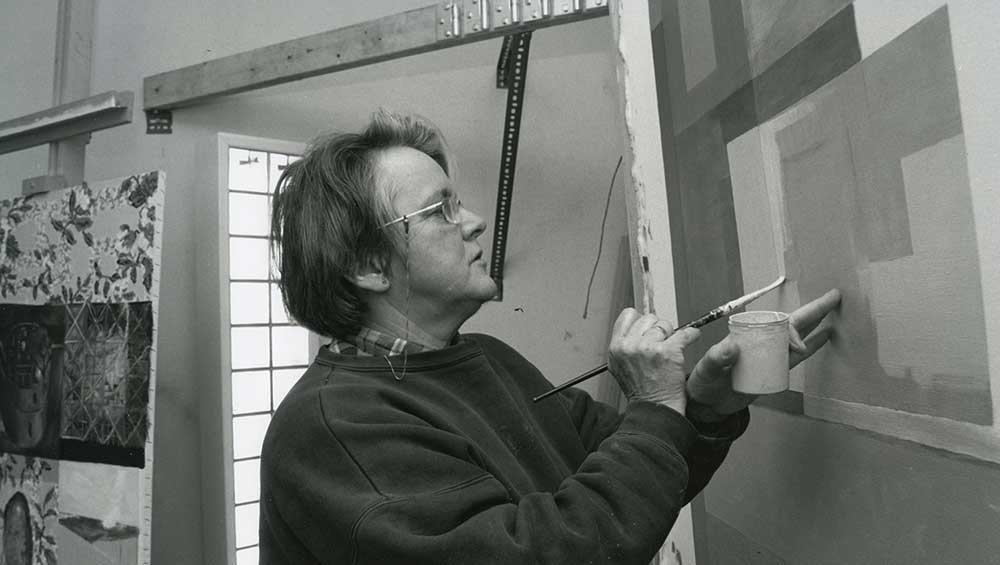
Vivienne Binns in her Curtin studio (Canberra), 1992. Photo: Alex Fiveash, courtesy of the artist.
Museum of Contemporary Art Australia, Sydney
15 July – 25 September 2022
by JANET McKENZIE
Vivienne Binns: On and Through the Surface is a comprehensive survey of the artist’s six decades of innovative practice. First shown at Monash University of Modern Art (Muma), it is now at the Museum of Contemporary Art in Sydney (MCA) in a slightly different iteration; together, they feature more than 100 key works from nationwide collections, in the first retrospective of her practice. Collaborative works are shown alongside Binns’s works on paper, paintings and assemblages; environments, performances and happenings; enamels, slideshows and installations. On and Through the Surface is the product of extensive scholarship by Hannah Mathews, senior curator at Muma, and Anneke Jaspers, senior curator, collection, at MCA. In addition, an excellent catalogue enables viewers to understand the relationship between the highly autobiographical works and those that challenge colonial assumptions and power imbalance. The work remains emphatically contemporary and vital. It is experimental, eclectic, inextricably dictated by materials and cultural circumstance.
-(1).jpg)
Vivienne Binns. Vag Dens, 1967. Synthetic polymer paint and vitreous enamel on composition board, 122 (H) x 91.5 (W) x 3 (D) cm. National Gallery of Australia, Canberra . Purchased in 1978. © Vivienne Binns / Copyright Agency.
Binns (b1940) has been a pivotal figure in Australian art since her first exhibition, at the age of 27, Vivienne Binns: Paintings and Constructions at Watters Gallery, in Sydney in 1967. Two works in particular, Vag Dens (1967) and Phallic Monument (1966) challenged the art world and the role art could and might play. The work was widely criticised and described as offensive for its provocative sexual imagery: the critic Elwyn Lynn went as far as to describe it as “affronting masculinity”.
.jpg)
Right: Vivienne Binns, Phallic Monument, 1966. Synthetic polymer paint on composition board, 91.5 x 106 cm. Installation view, On and through the Surface, Museum of Contemporary Art Australia, Sydney, image courtesy the artist, National Gallery of Australia, and Museum of Contemporary Art Australia © the artist. Photo: Jacquie Manning.
Half a century on, the power of the conscious-raising feminist works from the 70s and 80s, along with the politically challenging work of the 90s, has not diminished. The power of her explosive painting The Aftermath and the Ikon of Fear (1984-85) retains relevance to present-day uncertainty. The relationship in her elegant and mysterious painting of the individual in relation to the wider world is paramount.
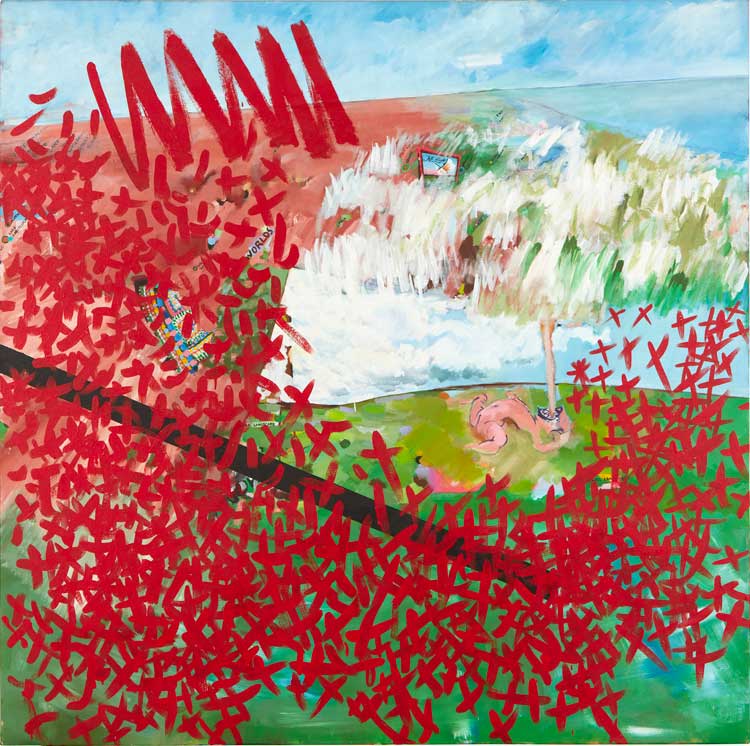
Vivienne Binns. The aftermath and the ikon of fear, 1984-85. Synthetic polymer paint on canvas, 160 x 160 cm. Museum of Contemporary Art Australia and Tate, with support from the Qantas Foundation in 2015, Purchased 2020.
© Vivienne Binns. Photo: Zan Wimberley.
Binns is unapologetic in her embrace of all aspects of decoration and found materials – cloth, embroidery, family photographs assembled and reconfigured. She has an enduring interest in domestic lives, overlooked lives and quotidian ritual. The very process of making, the strength achieved on a personal level through collaboration is evident in all the completed works. She explores these pivotal themes of the female experience through the very processes of making art, and inevitably the work on show challenges accepted orthodoxies. Fifty years since she exploded myths of gender imbalance and conventional roles, her work is both mysterious and universal.
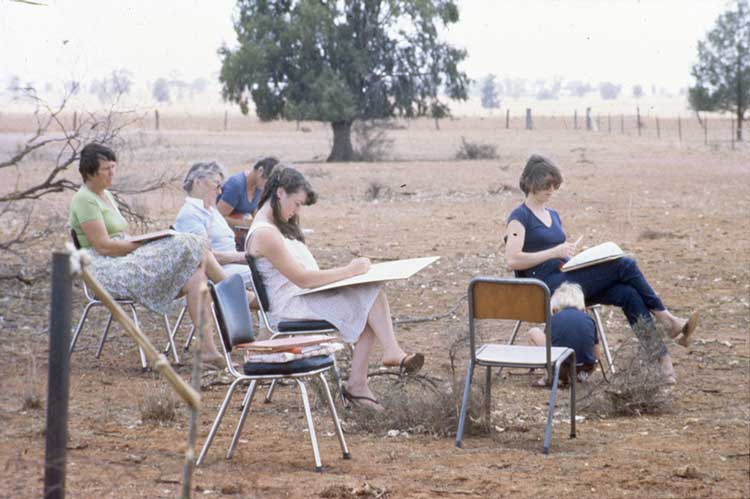
Vivienne Binns and participants. Full flight: views of life in the Central Western region of NSW through the creative expression of those who live there, 1981-83. Artist-in-community project, including workshops, murals, posters, bulletins, newsletters. Held in Bathurst, Condobolin, Cowra, Fifield, Forbes, Grenfell, Lake Cargelligo, Lithgow, Molong, Murrin Bridge, Nyngan, Orange, Parkes, Tottenham, Tullamore and Trundle. © Vivienne Binns. Photo: courtesy of the artist.
Binns came to prominence in the 1960s with psychedelic depictions of female sexuality. She was an important figure in the Women’s Art Movement, an Australian feminist art movement, and in the development of community arts in Australia. Through the 70s and 80s, her work in the community encouraged public participation in the arts. She was committed to a more inclusive art world where female experiences, from embroidery to icing cakes, was legitimate. In an interview in 2020 with Deborah Hart of the National Gallery of Australia, Binns said: “Art is not something that simply belongs in the museums and history books … when we opened our eyes and looked around us, we saw creativity and invention in all sorts of things … by children, by so-called ordinary people, by people in our family, by people who were just considered not important and amateurish …”
At art school, she was interested in Dada and surrealism. Her courageous and striking early painting is the product of astute observation from art history and from contemporary life, as well as from contemporary artists such as John Olsen, whose spatial relationships and intense fluid colour helped her to interrogate the power and limits of the picture plane. In works such as Orange Flam (1967), she chopped up paintings on wood and reconfigured them, experiencing physical and conceptual necessity as a means of questioning what art was and had been. It is the artist’s intuition that triumphs over and over again.
![Vivienne Binns. Not titled [abstract motif], 1966. Drawing in gouache and fibre-tipped pen (fineliner), 33.2 (H) x 20.3 (W) cm (image). National Gallery of Australia, Canberra. Purchased 1993.
© Vivienne Binns/Copyright Agency.](/images/articles/b/007-binns-vivienne-2022/169717-Super-Hi-Res.jpg)
Vivienne Binns. Not titled [abstract motif], 1966. Drawing in gouache and fibre-tipped pen (fineliner), 33.2 (H) x 20.3 (W) cm (image). National Gallery of Australia, Canberra. Purchased 1993.
© Vivienne Binns/Copyright Agency.
Her feminism grew from observing the dominance of male lecturers and the predatory tendencies of men in the art world. Yet she describes her art school experience as more than that and the consequence of soul-searching, through reading psychoanalysis. Self-examination to break through her background conditioning, she told Deborah Hart in that 2020 interview, was exhausting, intense and driven. “I was always working and trying to find my way and did a lot of these little drawings and … it was like this real breakthrough … these drawings just started to flow … they virtually appeared on the page and I just had to trace around them … that was part of the outflowing.” Quickly executed stream of consciousness works, such as No Title in pen on paper (1965-66), enabled the artist to visualise dream imagery, and navigate sexual themes with immediacy. Censorship in Australia in the 60s was tough and it was not uncommon for the vice squad to seize explicit artworks from galleries.
.jpg)
Vivienne Binns, installation view, On and through the Surface, Museum of Contemporary Art Australia, Sydney, image courtesy the artist, National Gallery of Australia, and Museum of Contemporary Art Australia © the artist. Photo: Jacquie Manning.
The 1980 exhibition Mothers’ Memories, Others’ Memories grew from a community arts project she worked on, based first at the University of New South Wales and then in the Sydney suburb of Blacktown, conceived to interpret “memories drawn from anecdotes, letters, diaries, handcrafts, photos from family albums”. In the artwork of the same name, Binns chose a postcard rack made up of screen prints on vitreous enamel on steel. The prints were attached using nylon thread to the anodised steel rack. The workshops were revealing, prompting Binns to have conversations with her own mother, which led to Self-Portrait Self-Image (1980), made using the taped interview and a two-channel slide show, one depicting the life of Joyce Binns and the other revealing the corresponding years of Vivienne’s life. In the workshops in the community, Binns told Hart: “Women would light up when you started to talk about the family album … people would show the family album that their mother had made of their life and their mother’s view of their life wasn’t necessarily how they viewed their own life, but this was an interpretative process.” When the exhibition opened there was great enthusiasm, she said, but the visitors would often be so affected by the material on show that they would go away realising the need in their own lives to express their own narratives as distinct from their mothers’. It was about women, the power of complex female relationships. Autobiography and the power of familial privacy has played an important role in the establishment of feminist narratives. Since the #MeToo Movement, Binns’ work can be experienced and interpreted in different ways and with layers of new meaning.
.jpg)
Vivienne Binns. Suggon, 1966. Vitreous enamel on composition board, electric motor, synthetic polymer mesh, electrical component, steel,
122.2 (H) x 92 (W) x 16 (D) cm (unframed). National Gallery of Australia, Canberra Purchased 1977. © Vivienne Binns / Copyright Agency.
The early 80s were a peripatetic period when she focused on community projects in rural New South Wales and held workshops in public spaces, church halls, even in fields. She also worked in a studio in the Blue Mountains, which was in contrast to life in central Sydney. Then, following the death of her uncle, she lived in his house at Saratoga on Brisbane Waters on the coast north of Sydney. Here, her work explored new observations of water, the relationship between the water close to the house and the wider context of the South Pacific Ocean and how it defined a notion and understanding of place. In an artist’s statement for the 1994 exhibition Pacific Parts at the Watters Gallery, she described the marked shift in her work: “Having spent the first 20 years of art practice intensely involved with understanding how art permeates and works throughout different social contexts in Australia, in the mid-1990s I shifted my attention to considering what it meant to be an artist within the Asia/Pacific regions, living in a country taken over, 200 years ago, from its Indigenous inhabitants by people of Anglo/European stock. There are several streams and many layers to this investigation (which is more like a musing), sometimes accompanied by active research and travel, sometimes more passive, but ending up in fragments washed up on the beach, surfacing in the water or in, on and through the picture plane.”
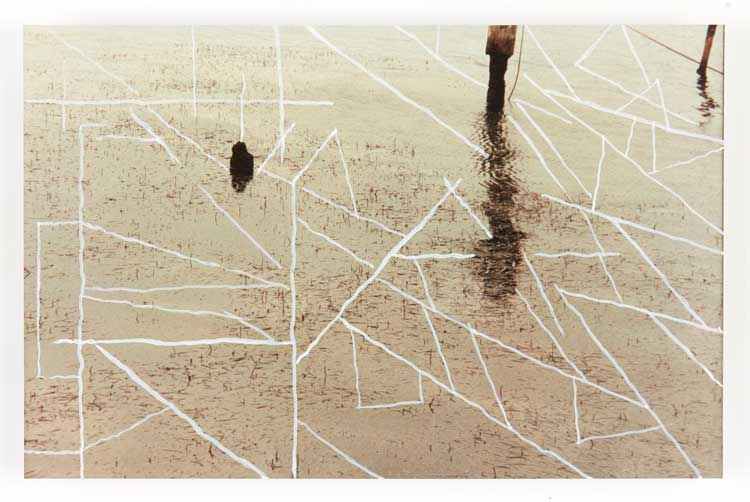
Vivienne Binns. Over neg 20 10 1994. Synthetic polymer paint on chromogenic print, 23 x 35.5 cm. Collection of the artist. © Vivienne Binns. Photo: Zan Wimberley.
On the north coast, she photographed the water repeatedly – the surface effects of light on the water – and examined the patterns left on the sand at low tide. In formal terms, she began to see the random patterning of shells distributed by natural forces, and explained them in terms of layers and layering, the manner in which light can break the surface apart. Water has long been a metaphor for human experience. In psychological terms, she was exploring water and light as “connective tissue” that brings together seemingly unrelated aspects of human experience. Looking at water in this context represented something of a breakthrough: the forensic examination of light, water and surface was similar in terms of self-analysis, scrutiny of self and heightened consciousness that she had carried out while a student and in the years following art school. Reconfiguring the formal elements she observed over two years on the coast established the basis of numerous paintings in the present retrospective, where a rigorous deep consciousness is conjured.
In Pacific Parts, she explains her process: “One of the main devices to assist in this process has been a tapa pattern, which was used for demonstration by Tongan participants at the Festival of Pacific Arts in the Cook Islands in 1992. Because it is based on a grid formation, it evokes, to European eyes, gridded surfaces with different purposes and different concerns with meaning. These are helpful confusions. Others are set up between craft, fine art, in the construction of visual surfaces that are flat, closed, layered and/or creating illusions of three dimensions. The tapa pattern ebbs and flows and may seem to stray a long way from its origins. It overlays other images and forms, sometimes like a reverse colonisation, but having the possibility for me of many comparisons and interpretations.
“There has been a constant and steady seepage of cultural information from the Pacific into Australian life, at least since white settlement. This has happened through little-observed processes, as the dominant rhetoric of politics, the arts and media reporting in Australia has been preoccupied with Britain, Europe and America. This seepage is a process, which interests me very much. Contrary to appearances it is, I believe, how certain significant shifts and changes take place.”
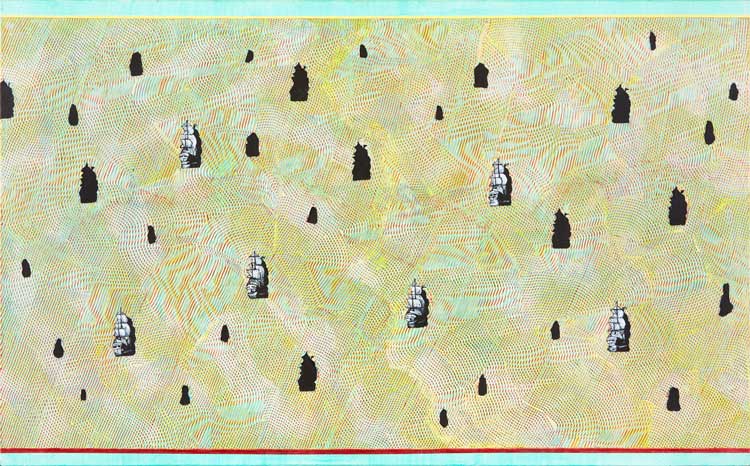
Vivienne Binns. Captain Cook in spinifex green, 2002. Synthetic polymer paint on canvas, 62.6 x 100.5 cm. Private collection, Canberra. © Vivienne Binns. Photo: Zan Wimberley.
Interculture (1992) interrogates the geometric patterning found in her Pacific travels. Many of the handicrafts that caught her attention were made by women: the tapa cloth in Tonga is a ceremonial bark cloth that also assumed the form of currency. The silken inner bark of the mulberry or fig tree came to represent peripheral culture and lost identity. Its transparency acted as a metaphor for the experiential layer upon layer in individual lives. She became interested in colonial history and the work of William Hodges, the artist who accompanied Captain Cook on his 18th-century journeys in the Pacific. Her own father’s experience in Papua New Guinea during the second world war fed her curiosity, as well as the former official war artists who became her teachers at the East Sydney Technical College in the late 50s. These influences were more authentic to her Australian experience, culturally and geo-historically, than European or American culture.
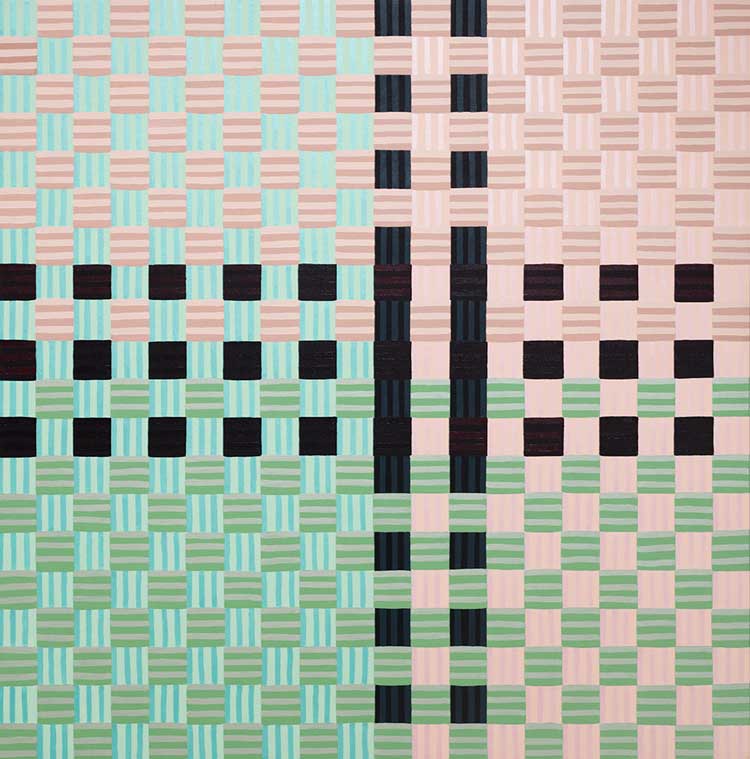
Vivienne Binns. In memory of the unknown artist: woven plastic cloth, gift from Ruth Waller, 1996. Synthetic polymer paint on canvas, 160 x 160 cm. State Art Collection, Art Gallery of Western Australia. Purchased through the Sir Claude Hotchin Art Foundation, Art Gallery of Western Australia Foundation, 1997. © Vivienne Binns.
In Memory of the Unknown Artist: Woven Plastic Cloth, Gift from Ruth Waller (1996) was the first in a series. It was created from a woven plastic cloth that, Binns said, reminded her of traditional weavings in the Cook Islands and Samoa “together with brightly coloured wools and plastics. I loved the cloth and gazed at it over time; in the way one does with household items, sometimes aware and other times in less conscious states. Most people noticed it and commented on it. It was brash and common in old middle-class terms.” Images by Binns that addressed global conflict and violence are mitigated by the value placed on quotidian life, perhaps alluding to the empowering and healing aspects of making and examining art.
.jpg)
Vivienne Binns. Tapa over a Republican Governor-General, 1993. Drawing in synthetic polymer paint, 25.5 (H) x 22.5 (W) cm (image), 25.5 (H) x 22.5 (W) cm (sheet), 28.0 (H) x 25.5 (W) cm (backing). National Gallery of Australia, Canberra. Purchased 1995. © Vivienne Binns / Copyright Agency.
The method of layering the photographs of waters at Saratoga enabled her to create an abbreviated tapa patterning through which she could subtly reframe dominant regional assertions about power and culture. Approximated tapa grids form the basis physically and conceptually for many of the sumptuous paintings and poignant assemblages that followed. Tapa Over a Republican Governor-General (1993) combines pertinent politics of the day with cultural beliefs to a point of intersection. When this methodology is combined with thickly applied acrylic paint using handmade combs, the impact is mesmerising.
In her artist statement to accompany her 2018 show It Is What It Is What It Is, Binns describes the power of her work, the essence of her visual truth telling: “I can’t be anything other than what all my life experience, training, desires, failures, genes and everything else has made me. I find myself saying: ‘I am what I am what I am.’ And part of what I am is that I’ve always questioned things and not taken them for granted, so that goes on. I’ve always been curious and that goes on. And I’ve always believed that it’s absolutely crucial to be as truthful as one can, to look honestly into oneself and the world quite ruthlessly, to be on the alert for where there’s self-deception or delusion and I’ve learnt to be very cautious when we believe that we’ve absolutely got it, when we feel we absolutely understand and know best. For me, it’s healthy and part of a searching mind for belief to go hand in hand with scepticism, a state that allows you to speculate and look to see what else might be there, to sense what the mind and feelings, through materials and actions might reveal and if indeed we can feel something true or that we’ve been deceived by smoke and mirrors. (Desire, belief, conventions, deceit etc.)”